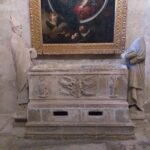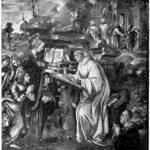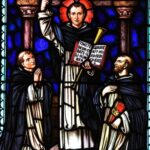
St. Eugenia
Saint Eugenia
When They Lived:
St. Eugenia is believed to have lived during the late 2nd century, around the year 258 AD.
Where They Lived:
St. Eugenia’s story originates in Rome, one of the most significant cities of the Roman Empire. However, her journey takes her across various regions, making her tale even more captivating.
Notable World Events During Their Time:
- The Decian Persecution (249-251 AD): St. Eugenia’s life unfolded during a period of intense persecution against Christians under the Roman Emperor Decius. This event had a significant impact on the Christian community, shaping their resilience and dedication.
- The Plague of Cyprian (251-266 AD): A devastating pandemic known as the Plague of Cyprian swept through the Roman Empire. This epidemic profoundly affected the social and religious dynamics of the time, leading to various interpretations and responses from different communities.
- Galen’s Medical Advancements: During St. Eugenia’s life, the renowned physician Galen was making significant contributions to the field of medicine. His works and discoveries influenced medical practices for centuries, showcasing the progress of human knowledge during this era.
- The Crisis of the Third Century: The Roman Empire faced a period of turmoil, known as the Crisis of the Third Century, marked by political instability, economic challenges, and frequent changes in leadership. This era had a profound impact on the empire’s structure and society.
- The Birth of Plotinus (c. 204-270 AD): The renowned philosopher Plotinus, a prominent figure in the development of Neoplatonism, was born during St. Eugenia’s lifetime. His philosophical ideas would later influence both Western and Eastern thought.
Their Patronage:
St. Eugenia is known as the patron saint of several diverse groups, adding to her intriguing legacy:
- Protector of Converts: St. Eugenia’s own journey from noble Roman woman to devoted Christian convert makes her a symbol of strength and inspiration for those undergoing spiritual transformation.
- Advocate for Gender Equality: Her story challenges gender norms, as she disguised herself as a man to study theology. This aspect of her life can inspire those advocating for gender equality and women’s rights.
- Patron of Students: St. Eugenia’s pursuit of knowledge, even in the face of adversity, makes her a fitting patron for students, scholars, and those on a quest for enlightenment.
- Intercessor against Epidemics: Given the historical context of the Plague of Cyprian during her lifetime, St. Eugenia can be invoked as an intercessor against epidemics, providing solace and hope during challenging times.
Born Rich
Eugenia was born in Rome into the noble house of Duke Philip and Claudia. She had two brothers. As a girl born into nobility, Eugenia had an excellent education for her time.
Her father, Philip, was sent to Alexandria, Egypt, as governor by emperor Commodus. As prefect of the city of Alexandria, her father governed all over the lands on the emperor’s behalf. Eugenia grew up in Alexandria with her family and enjoyed all the privileges due to her birth.
Most of what we know about Eugenia comes from legend. According to the story, Eugenia, born a pagan, chanced upon the Christian gospel at Alexandria. Her heart was particularly inflamed when she came across the Epistles of St. Paul. She yearned to know more about the faith.
Young Eugenia grew into a lovely and well-cultured young lady. Suitors fell over themselves, seeking her hand in marriage. Notably among her suitors was Aquilus, son of a consul. But Eugenia turned down all marriage requests. In the secret of her heart, she wants to remain a virgin.
Flight From Home
Eugenia sought the permission of her parents to visit a rural villa belonging to the family in the suburbs. But her true intention was to see the Christian area. On passing through the Christian territory, she heard a group of Christians singing hymns, and an undying passion for the new faith was enkindled in her.
This permission is granted because she goes with her servants and is carried on a litter.
One day, Eugenia decided to become a Christian. She confided in her servants, Protus and Hyacinthus, and they came up with an escape plan. Eugenia cut her hair and disguised herself as a man. With the help of her servants, she fled from home at the opportunity of a routine day out.
Dressed as a man and changing her name to Eugenius, she met Helenus, the bishop of Heliopolis, who baptized her and welcomed her into the Christian fold. She joined the monastery, still disguised as a man.
At the abbey, Eugenia was distinguished as a young, devoted, and pious abbot. She pursued a life of austerity and acquired the gift of healing. For a few years, she was hidden in the abbey, living as a monk.

The Temptress
Eugenia healed a wealthy noblewoman named Melanthia of her illness by praying and using anointed oil. Melanthia was burning with lust for the young and beautiful, and she assumed the young monk had made sexual advances on her,which Eugenia promptly rejected.
Pissed off by her rejection, Melanthia decided to play Potiphar’s wife. She raised the alarm, accusing Eugenia of sexual harassment. Eugenia was made to appear before a judge to answer the accusations against her. The judge was her father.
Facing the court, Eugenia boldly defended herself against all accusations. The highlight of her defense was when she confessed she was a lady and tore her clothes to prove it. She also revealed to her father who she was.
Her family’s joy knew no bounds when they found her again. They had searched and mourned her loss.
Martyrdom
Eugenia’s family converted to Christianity along with her. Christianity in that era was a forbidden faith under Roman rule. For becoming a Christian, her father, Philip, was assassinated on the order of the Emperor. The rest of the family went back to Rome.
In Rome, Eugenia converted many, especially young maidens. Her mother,Claudia, built a wanderer’s home and aided the poor.
Eugenia suffered martyrdom. She was first tied with a stone around her neck and thrown into the Tiber, but the stone untied, and she was unharmed. She was cast into a blazing fire but remained unscathed. Next, Eugenia was left in a dark cell for about 10 days without food,but Christ illuminated her cell and fed her with a shining white loaf.
Finally, on December 25, 258, Eugenia was beheaded with a sword.
5 Interesting Facts About St. Eugenia
- Eugenia was beheaded on a date that now hosts the most celebrated
birthday in Christendom. 25 December, the birthday of Jesus
Christ. - Eugenia’s faith led her family to the path of sainthood. Her father,
mother and her servants, Protus and Hyacinthus, who were martyred
are also honored as saints. - According to legend, Eugenia, after her death, appeared to her mother.
in a dream to inform her of the day she will be killed. - Eugenia is depicted in a church painting in the small village of
Santa Eugenia in North Portugal, dressed in the Roman era
attire. - When Eugenia was led to the temple of Diana in Rome to be beheaded,
Her prescence caused the temple to be shattered into ruins.
Prayer to St. Eugenia
There is no official prayer for Saint Eugenia.



